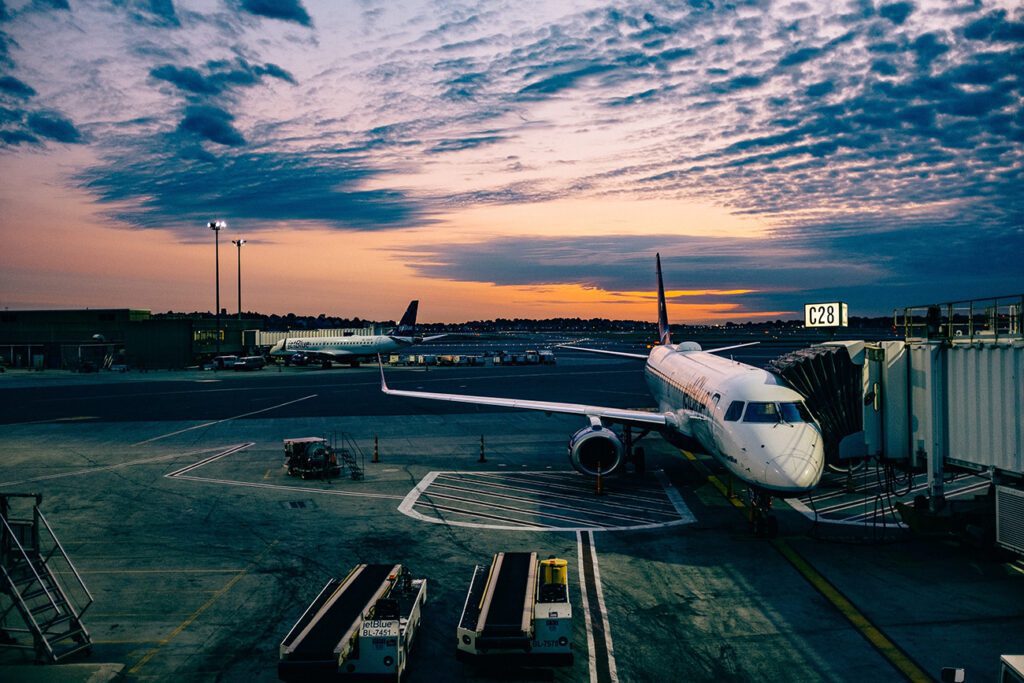Do you know your last flight had a huge impact on climate change?

If I asked you about the real culprits behind climate change, how long would it take you to acknowledge air travel as a cause? You may think of Fossil fuel use, Deforestation, Pollution, or rapid Industrialization as the primary causes of climate change. Well, you are right. But, you are neglecting climate change due to transport.
Transport makes an undeniable impact on climate change too. Several factors require awareness when it comes to Air traveling. The negative influence of air traveling on our environment is explained in depth.
But before that, let’s talk about climate change to comprehend the necessity of this matter.
Should we worry about Climate change?
Climate change is real. For the first time in many years, the UK has recently experienced a heatwave. While the masses prepared for a scorching 40 degrees summer, experts warned thousands could even die. The terrifying effects of climate change include:
- Rising temperatures and sea levels.
- Extreme and unpredictable weather conditions.
- Land degradation.
- Loss of degradation and biodiversity.
Besides having adverse effects on our environment, climate change imposes significant social impacts too.
Social Impacts of climate change
- Poverty
- Increased chance of widespread diseases
- Loss of livelihood
- Food and water shortages globally
- Malnutrition
- Displacement of masses
- Work difficulties
Experts explain that in 2020, almost 302 cities worldwide have notified that climate change made the elderly population most vulnerable to its effects.
All of these social impacts account for the negligence of our carbon footprint.
How is taking a flight linked to climate change?

You may have recently taken a flight for a vacation abroad or had to fly for an important meeting. The real deal is the contribution of commercial air travel to greenhouse gas emissions, around 4%. With an increased population and demand, the percentage will only exponentially increase within a few years.
The United Kingdom has roughly increased 88 percent of its global Aviation by compared to 1990. Policymakers must plan a Net Zero Strategy, or the situation will be impossible to handle.
Impact on Climate Change
Aviation is heavily dependent on its jet engine. The engine burns fuel to provide energy. The same burning of jet fuel expels substantial amounts of Carbon Dioxide and non-Carbon Dioxide emissions, including Nitrogen oxides, Water vapors, Sulphate aerosols, and Soot. All of these individuals have an immense effect on our atmosphere.
Carbon dioxide emitted by aviation persists in our environment for countless years. The coming generations will have to face the outrageous consequences of each flight we have taken in the past.
It is also crucial to create awareness about the non-Carbon Dioxide emissions emitted by an aircraft from burning its jet fuel. When you’re flying several kilometers high to reach your destination, the Nitrogen oxide released from the engine interacts with other gases in the atmosphere on the same day. High altitude makes it easier for these gases to combine with oxygen and introduce ozone into our environment.
When you land, the gases make their way into the atmosphere to start chemical reactions that eventually culminate in Global warming. Ozone, a highly reactive Greenhouse gas, alongside Carbon dioxide, has detrimental effects on climate change. The minute these gases combine, their potency will escalate.
A salient outcome of flying is the Contrails (Condensation trails). These are clouds of tiny ice crystals produced exclusively by the same aircraft, having the credit of releasing CO2 emissions. Experts believe contrails rank second as a contributor to climate change after Carbon dioxide. The only relieving point is that they don’t remain in the environment for years as they are short-lived compared to CO2 emissions. The origin of Contrails is Soot, a non-Carbon Dioxide emission from engine exhaust mixed with cool, humid air. The thick, white streaks essentially play the role of clouds by reflecting sun rays toward the sky and capturing heat radiated by the earth at night.
Aircraft exhaust may as well account for the Cloud formation. This phenomenon is yet unclear and needs research but contributes further to climate change.
Not only does an aircraft contribute to global climate change, but it liberates global Air pollution as well. The main issue is fossil fuel combustion. Imagine how many people are flying right now while you read this article. They are completely disregarding the effects of climate change on everyone globally.
Why is the focus on flying?
When you take a flight from Singapore to New York, you travel almost more than 15,000 kilometers. Indeed, sitting on a plane is tiring work, but each passenger needs to worry about the Carbon footprint they will be leaving. It will take hundreds of years to reverse the effects. For hours and hours, an aircraft is burning fossil fuels and making our planet vulnerable to even more climate change.
Not so long before, we survived a global pandemic. While it affected our daily routines, the
The aviation industry faced a 52.6% reduction in 2020 compared to the previous year.
This resulted in delaying Global warming to about five years only. The apparent reason lies in the persistence of previous Carbon Dioxide emissions. The constant emissions of all the past flights from so many years still play their significant roles.
There is a dire need to publicize the fact that emissions from an aircraft last for many years. Only then will we realize the urgency of this matter.
Air pollution by flights related to climate change
Air pollution occurs when any chemical, physical or biological agent corrupts the air quality. It is no secret that Industrialization, Household combustion, Motor vehicles, and Deforestation contaminate the atmosphere. Yet, the predominant responsible factor for Air pollution is Flying. The emissions released by an aircraft cause immense pollution.
Not only will Air pollution affect our atmosphere, but it has an undeniable effect on human bodies too. Low-quality air-conditioning inhaled will cause hazardous respiratory problems and can even be fatal.
Air pollution is responsible for 6.7 million deaths worldwide, in 2019, with an estimated 1.8 million deaths in China and 1.7 million in India. The numbers are alarming. If we continue our living standards, then the repercussions will be doubled.
Does Carbon dioxide emissions affect aircraft?
The far-reaching effects of climate change apply to airports too. Consequences include a reduced performance of the aircraft, potential damage to infrastructure, and delayed schedules. We have all witnessed the vulnerability of airports to increased chances of flooding, interruption of flights, and even cancellation. Such uncertainties create panic and disrupt everyone’s smooth plans.
Little do we realize that this is all due to our activities. Human activities account for the bulk of Carbon dioxide emissions, leading to climate change.
In 2019, over 393 million metric tons of Carbon dioxide emissions were liberated by an aircraft. In six years, the total emissions are anticipated to increase by over 100 million metric tons of CO2 globally. There is a shared responsibility on every individual to reduce Carbon emissions.
Do we have other options?
There is a growing demand for Air travel. If you peacefully sleep at night thinking that you have planted a tree today and performed your responsibility towards reducing climate change, then you may be mistaken.
Our enthusiasm for flying demands a massive scale reduction of Greenhouse gas emissions. The benefits of soaring need a collective re-evaluation. Taking a year off air travel won’t significantly impact our environment, but if it inspires others, we can create a significant influence.
Some people have to travel to different cities to meet their families and contemplating other options like trains or buses will benefit our environment too.
You may also reduce your flying by combining trips and video conferencing. Such steps help convince our friends, family, and colleagues to be more responsible.
Flying must be a necessity and not an easy getaway for fun.
Do we have any sustainable flying options with zero emissions?
The options stated above are all practical and valid. But at times, we have no other option but to travel by air.
It might be surprising, but some companies intend to develop commercial aircraft with a zero-emission policy by 2035. The deployment of Hydrogen technologies, among other Green options, is considered valuable when we think of a future of zero-emission aircraft.
The basic concept behind these Hybrid-hydrogen aircraft is the application of gas turbine engines that are modified enough to generate power by Hydrogen propulsion. The fuel used for combustion is Liquid Hydrogen. Hydrogen fuel cells also produce electrical power, and together they can promote an effective hybrid-electric propulsion system.
These technologies will soon be practical, and the objective of reducing carbon emissions through Air travel will be achieved. These planes can revolutionize air travel.
We still have a long way to get rid of the previously entrapped greenhouse gases in our atmosphere.
Ground Transport
An expert in sustainability and low-carbon transitions at the University of Leeds explained that while considering low Carbon emissions in terms of traveling, buses, and coaches make the best choices. Aircraft and cars leave the most carbon footprint on an individual in the environment.
Ground transport is also much more cost-friendly and enjoyable as you will get to explore new destinations. Trains often include the shortest routes since they have a planned track. For short distances, they are ideal as you don’t have to wait for your luggage and queue at security points like in airports.
Miles by miles, a single flight that we take has numerous impacts on climate change. Unknowingly, we often comply with such steps, which are dangerous for us and many generations ahead.
To reduce carbon emissions, we have to take responsible steps that might be as simple as taking one flight a year for vacations abroad rather than three, transferring to online Zoom meetings, or even shifting to trains for intercity travel. Keep in mind that a single individual’s choice of traveling also impacts those surrounding the person. Everyone can consider and implement more Green options for a safer future. Only you can decide whether the next flight you are going to take is crucial or not.






Responses